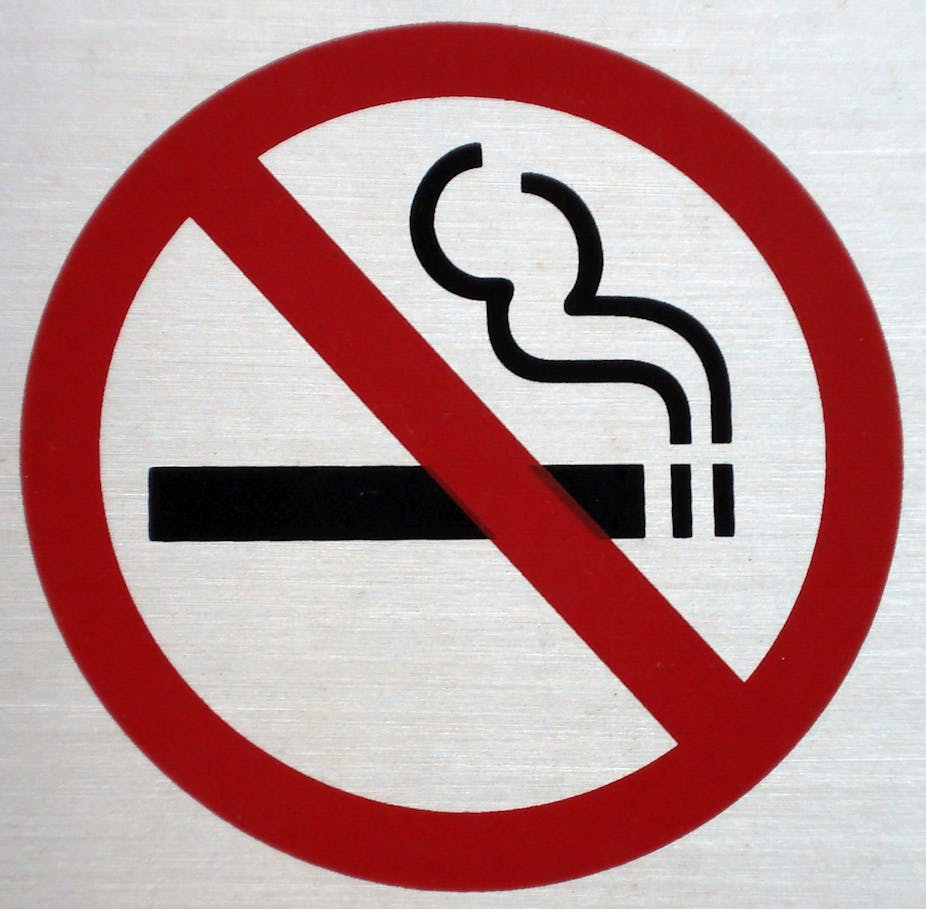In 1863, Fyodor Dostoevsky wrote, “Try to pose for yourself this task: not to think of a polar bear – and you will see that the cursed thing will come to mind every minute.”
According to a recent experiment conducted by my colleagues and me, Dostoevsky’s observation about ironic thought processes may have public health implications for no-smoking signs.
Our research suggests that smokers may be more motivated to reach for a cigarette when they encounter a representation of one in an image – even if it has a red line through it. Walking past one of these familiar icons can cause craving for cigarettes, whether the sign is consciously noticed or not.
Priming – not just smoke and mirrors
Objects, words, and symbols in the everyday environment can influence people’s thoughts and behaviours, even though they are often outside of conscious awareness. This is called “subconscious priming” and decades of research has shown that it’s a real and pervasive part of our daily experience.
Rain outside a window, even if not consciously noticed, can make people feel that their gloomy mood must stem from dissatisfaction about life in general; the presence of a briefcase in the room can boost economic drive; holding a warm cup of coffee makes people likelier to trust a stranger; and scrubbing one’s hands can wash away moral guilt.
Even when people consciously notice certain messages, if they’re framed negatively – as with the “no” in no smoking – the brain tends to subconsciously discount the negation. Freud noticed this back in 1925 when he noted, “We never discover a ‘no’ in the unconscious.”
A smoking gun
Our new finding stems from an experiment conducted at Yale University in 2010 in which a sample of smokers were randomly assigned to two groups. The first group viewed a stream of photographs depicting everyday scenes and locations: a sidewalk café, an airport lounge, a playground, and so on.
A subset of these images included a no-smoking sign placed in an inconspicuous location in the image (above a door frame, for instance, or on a table). The second group (the control group) viewed the same images with the no-smoking signs digitally removed.
Participants were first asked to judge whether a professional or an amateur photographer had taken each photograph. This was designed as a distraction task to occupy participant’s attention so that exposure to the no-smoking signs was truly passive and incidental – as it is in real life.
Once the smokers had viewed the stream of photographs, they participated in a “joystick” motivation task. In this task, the participants were shown a series of objects on a computer screen and told to “knock them off the screen” by moving the joystick as quickly as they could. The objects shown were everyday items (a soccer ball, a pencil, a can opener) mixed with a few smoking-related objects (a lit cigarette, an ashtray).

Previous research suggests that when people move their hand toward an object in a certain way, the brain treats this movement as an avoidance gesture. In a joystick or lever paradigm, people are generally quicker to move the lever (and consequently their hand) toward objects they are motivated to avoid, as if pushing them away.
Moving a lever towards the body, on the other hand, is treated as a “pulling toward” motion – an “approach” gesture, like you’re trying to draw the object closer to you. Given these motivational orientations, when participants are instructed to move a lever in the “pushing away” direction, they’re quicker to perform the motion when they are shown an image of something they wish to avoid, such as a snake. But they’re slower to perform the motion when shown a desirable object, such as an ice-cream cone. If instructed to move the lever towards the body, this instinct is reversed.
By instructing participants in our smoking study to move the lever first one way and then the other, while watching the stream of objects, split-second differences in response times could be recorded for the various stimuli. A score that reveals the degree to which participants were motivated to approach or avoid each item is then generated.
This method allowed us to assess levels of motivation to attain or reject the objects we displayed without participants’ knowing what was being measured. The finding? Incidental exposure to no-smoking signs dramatically increased the rate of cigarette-approach movements in smokers, all outside of participant awareness.
Igniting debate
Researchers must next evaluate how this subconscious effect manifests itself in the lives of smokers. While not every smoker who casually observes a no-smoking sign will be prompted to reach for a pack of cigarettes, even a weak influence on behaviour can be enough to tip the balance when the individual is deciding between one course of action and another.
While just a small step towards evaluating the impact of no-smoking signs, this research should prompt public health advocates and policymakers to further investigate their signage strategy. As more studies in this area are conducted, we may discover that plastering a city with thousands of bright red “craving reminders” may not the most effective way to curb smoking.
Acknowledgement: This article is adapted from a research report written by the author for The Oxonian Globalist, a student magazine at the University of Oxford.

